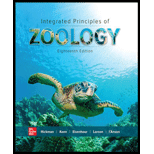
Explain how ocean acidification is likely to affect molluscs. Describe the long-term effects of this process on human economies.
To explain: The effect of ocean acidification on molluscs.
Introduction: The increase in the atmospheric CO2 due to various factors, initiates the chemical reactions in the environment. These reactions decrease the pH of the ocean, rendering it to be more acidic.
Explanation of Solution
The acidic ocean causes the reduction of biological availability of the calcium, making its uptake difficult by the organisms. Calcium is a critical element for the development of molluscs shells. The shells become softer, thinner and weaker in organisms such as clams, oysters, mussels and scallops, when present in an acidified ocean. The decrease amount of available calcium also causes the failure of larval abalone to develop normally and creating normal shells. The non-shelled molluscs like squid and octopi may also be affected by the acidification, as it increases the algal turf and seagrass bed. This changes the community, which may act on these molluscs.
To determine: The long-term effect of ocean acidification on human economies.
Introduction: Molluscs have significant importance as a source of food for many people all around the world. Tonnes of molluscs are harvested for food every year.
Explanation of Solution
The acidification of the ocean declines the population of healthy molluscs. A healthy mollusc fishery depends on healthy oceans. The deterioration of the ocean’s environment hampers the fishery. This causes economic loss to the fishery industries.
Want to see more full solutions like this?
Chapter 16 Solutions
Loose Leaf For Integrated Principles Of Zoology
- What is the structure and function of Eukaryotic cells, including their organelles? How are Eukaryotic cells different than Prokaryotic cells, in terms of evolution which form of the cell might have came first? How do Eukaryotic cells become malignant (cancerous)?arrow_forwardWhat are the roles of DNA and proteins inside of the cell? What are the building blocks or molecular components of the DNA and proteins? How are proteins produced within the cell? What connection is there between DNA, proteins, and the cell cycle? What is the relationship between DNA, proteins, and Cancer?arrow_forwardWhy cells go through various types of cell division and how eukaryotic cells control cell growth through the cell cycle control system?arrow_forward
- In one paragraph show how atoms and they're structure are related to the structure of dna and proteins. Talk about what atoms are. what they're made of, why chemical bonding is important to DNA?arrow_forwardWhat are the structure and properties of atoms and chemical bonds (especially how they relate to DNA and proteins).arrow_forwardThe Sentinel Cell: Nature’s Answer to Cancer?arrow_forward
- Molecular Biology Question You are working to characterize a novel protein in mice. Analysis shows that high levels of the primary transcript that codes for this protein are found in tissue from the brain, muscle, liver, and pancreas. However, an antibody that recognizes the C-terminal portion of the protein indicates that the protein is present in brain, muscle, and liver, but not in the pancreas. What is the most likely explanation for this result?arrow_forwardMolecular Biology Explain/discuss how “slow stop” and “quick/fast stop” mutants wereused to identify different protein involved in DNA replication in E. coli.arrow_forwardMolecular Biology Question A gene that codes for a protein was removed from a eukaryotic cell and inserted into a prokaryotic cell. Although the gene was successfully transcribed and translated, it produced a different protein than it produced in the eukaryotic cell. What is the most likely explanation?arrow_forward
 Biology Today and Tomorrow without Physiology (Mi...BiologyISBN:9781305117396Author:Cecie Starr, Christine Evers, Lisa StarrPublisher:Cengage LearningEssentials of Pharmacology for Health ProfessionsNursingISBN:9781305441620Author:WOODROWPublisher:Cengage
Biology Today and Tomorrow without Physiology (Mi...BiologyISBN:9781305117396Author:Cecie Starr, Christine Evers, Lisa StarrPublisher:Cengage LearningEssentials of Pharmacology for Health ProfessionsNursingISBN:9781305441620Author:WOODROWPublisher:Cengage Human Biology (MindTap Course List)BiologyISBN:9781305112100Author:Cecie Starr, Beverly McMillanPublisher:Cengage Learning
Human Biology (MindTap Course List)BiologyISBN:9781305112100Author:Cecie Starr, Beverly McMillanPublisher:Cengage Learning Concepts of BiologyBiologyISBN:9781938168116Author:Samantha Fowler, Rebecca Roush, James WisePublisher:OpenStax College
Concepts of BiologyBiologyISBN:9781938168116Author:Samantha Fowler, Rebecca Roush, James WisePublisher:OpenStax College





